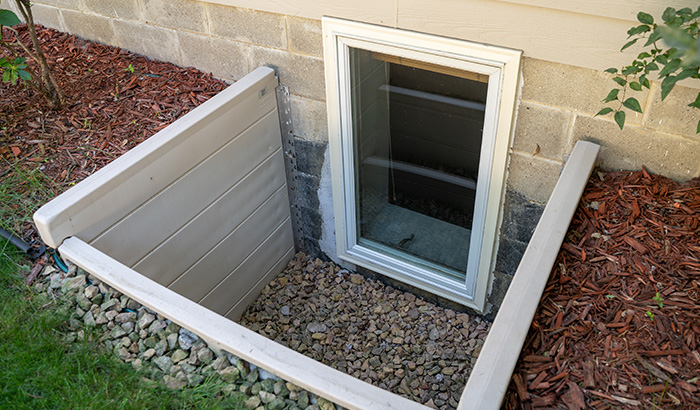Keeping your basement dry is an important part of maintaining your home’s structural integrity and air quality. Waterproofing protects against moisture seepage, mold growth, and serious water damage that could undermine your home’s foundation.
Moisture may cause musty odors, structural damage, and mold growth, harming health and damaging materials like wood and carpet. Water infiltration might also lead to costly structural repairs.
This blog explores diverse waterproofing techniques to help you choose the right method for your home’s needs. Whether addressing minor dampness or preparing for potential flooding, understanding these options will empower you to protect your basement effectively.
Exterior foundation seal
Opting for an exterior foundation seal is one of the most robust waterproofing strategies to protect your home against severe water damage. This method involves applying a polymer-based sealant to the exterior walls of your foundation, forming a solid barrier against moisture penetration.
Here’s a closer look at the application process and the benefits this method offers:
Application process
Excavation
The first step in applying an exterior foundation seal involves excavating the soil around your home down to the foundation footings. This extensive digging is necessary to expose the entire exterior surface of the foundation walls.
Surface preparation
Once exposed, the foundation’s surface requires thorough cleaning to ensure optimal adhesion of the waterproofing materials. All dirt, grime, and loose material must be removed to create a smooth surface.
Applying the waterproof membrane
After preparing the surface, you’ll apply a polymer-based waterproof membrane. This membrane is meticulously spread across the entire exterior foundation wall, covering every nook and ensuring complete coverage for maximum protection.
Durability and benefits
Long-lasting protection
One of the primary advantages of an exterior foundation seal is its durability. Properly applied, this waterproofing barrier will protect your home for at least 20 years without needing significant maintenance. This long lifespan makes it an excellent investment for new construction or extensive renovations.
Enhanced structural support
Beyond blocking moisture, the polymer-based sealant helps strengthen your foundation walls’ structural integrity. Binding to the surface adds an additional layer of support, reducing the risk of cracks and structural wear over time.
Comprehensive moisture barrier
The exterior foundation seal acts as a robust moisture barrier, preventing water from penetrating through the foundation walls. This comprehensive protection is especially valuable in areas prone to heavy rain or in homes situated on high water tables.
Even though it costs more upfront, choosing an exterior foundation seal, pays off in the enhanced security and durability it provides. It’s particularly recommended during the construction phase or in situations where lower-level water damage has been a persistent issue.
By investing in this method, homeowners ensure a drier, healthier basement environment and reduce the potential for costly future repairs.
Interior waterproofing solutions
When it comes to safeguarding your basement from the inside, a variety of interior waterproofing solutions offer protection, ranging from advanced drainage systems to simple sealants and paints. These methods cater to different levels of moisture challenges; you can tailor them to meet your home’s specific needs.
Drainage systems: Foundation for moisture management
One of the most comprehensive interior waterproofing solutions is the installation of a drainage system, which effectively manages rising groundwater and directs it away from your home’s foundation.
Installation process
- Jackhammering the basement floor: The process begins by carefully jackhammering the perimeter of your basement floor to create a trench. This allows for the installation of the drainage components directly at the foundation level where water ingress occurs.
- Placing a basin and sump pump: Inside the newly created trench, you’ll place a specially designed basin. This basin collects incoming water and serves as the critical connection to a sump pump. The sump pump then activates when water levels rise, pumping water out and away from your home.
- Directing water away: The sump pump discharges the water through a pipe that leads it safely away from your foundation, ensuring that moisture does not accumulate around the structural base of your home.
Sealants and waterproofing paints: Addressing minor moisture intrusions
For homes experiencing minor moisture issues rather than outright flooding, applying sealants or waterproof paints is an effective and economical solution.

Types of sealants and paints
Concrete and silicate-based sealers
These sealers penetrate the pores of concrete foundation walls, forming a hard, waterproof surface. They are ideal for basements with damp walls because they lock out moisture while maintaining the integrity of the concrete.
Acrylic-based waterproofing paint
This paint forms a moisture-resistant film over the surface of basement walls. It is particularly useful for preventing mold and mildew growth, as it seals the surface from moisture and creates a barrier against humidity.
Benefits of interior waterproofing solutions
Customizable moisture control
Whether you choose a full drainage system or simpler sealant applications, you can tailor each solution to address the specific moisture challenges in your basement. This tailored approach ensures that you invest in what’s exactly needed for your home.
Enhanced home value and usability
By maintaining a dry basement, these waterproofing methods enhance the overall value and usability of your space. A dry basement helps prevent structural damage and health issues related to mold and mildew.
Cost-effective maintenance
Interior waterproofing, especially sealants and paints, provides a cost-effective way to maintain your basement’s integrity. These solutions require minimal upkeep yet offer protection against moisture penetration.
Incorporating the right interior waterproofing strategy provides peace of mind by effectively managing the moisture levels in your basement. Whether dealing with minor dampness or more extensive water issues, these solutions ensure your basement remains dry, healthy, and functional.
Window well drainage systems: Essential for basement protection
Managing precipitation and groundwater effectively
Properly managing precipitation and groundwater helps ensure a dry and structurally secure basement. Window well drainage systems are central to this task, effectively addressing the challenges posed by water accumulating near basement windows.
Strategic water diversion
Window well drainage systems are specifically designed to divert water away from the foundation, preventing it from pooling near basement windows where it seeps into the home. These systems capture rainwater and melting snow before they infiltrate your basement, channeling them into designated drainage paths that lead away from the structure.
Enhancing structural integrity
These drainage systems help maintain the structural integrity of the foundation by keeping the area around the basement dry. Consistent exposure to moisture weakens foundation materials over time, leading to cracks and potential collapse. Window well drainage systems mitigate this risk by ensuring that groundwater and precipitation are efficiently managed.
Critical role in home safety
Incorporating window well drainage systems protects your home’s physical structure and enhances overall safety. By preventing water accumulation and the subsequent issues it causes, these systems help avoid costly and potentially hazardous situations such as mold growth and water damage.
Effectively managing precipitation and groundwater through these systems is essential for any homeowner looking to safeguard their property and ensure a healthy living environment.
Challenges of uncovered window wells
Uncovered window wells present several issues that compromise the safety and integrity of your basement.
Pooling and seepage
One of the main problems with uncovered window wells is the accumulation of rainwater and melting snow. This pooling water easily seeps through basement windows and walls, creating a high risk of water damage and potential flooding.
When water consistently collects in these areas, it saturates the surrounding soil, increasing pressure on the foundation and potentially leading to structural weaknesses.
Debris accumulation
Another challenge is the accumulation of leaves, sticks, and other debris in the window wells. This debris quickly blocks the drainage system and prevents water from escaping.
Such blockages not only worsen the issue of pooling but also make routine cleaning tasks more demanding and frequent. Clearing out a clogged window well is not only labor-intensive but also necessary to restore effective drainage and prevent water buildup.
Impact on maintenance
The presence of debris and persistent water accumulation necessitates frequent maintenance checks, which are both time-consuming and costly. Homeowners must regularly inspect these areas to ensure that drainage systems are not obstructed and that the structural integrity of the window wells is not compromised.
Addressing these challenges is crucial for maintaining a dry and safe basement environment. Effective solutions such as installing window well covers mitigate these issues by preventing the accumulation of water and debris, thereby protecting the basement from the adverse effects of exposure to the elements.
Window well covers: enhancing waterproofing efficiency
Prevent basement flooding
Window well covers prevent basement flooding by stopping water accumulation. They effectively shield the wells from rain and snow, ensuring that water does not pool around basement windows, a common entry point for moisture that results in expensive water damage.
Protect against precipitation and extend window frame life
These covers serve multiple protective functions:
- Blocking precipitation: They block rain and snow, protecting window frames from continuous moisture exposure, which leads to rot and compromises the structural integrity of the wood.
- Preventing freeze-thaw damage: By guarding against snow and ice accumulation, the covers avert freeze-thaw cycles that stress and damage the window frames.
Control soil moisture and drainage system efficiency
The covers also play a role in maintaining soil moisture balance:
- Soil moisture levels: By controlling soil moisture around the foundation, the covers prevent oversaturation that can pressure the foundation walls, potentially leading to cracks and structural issues.
- Reducing drainage system workload: With reduced water accumulation in the window wells, the basement’s drainage system, including sump pumps, operates more efficiently, lowering the risk of failures during intense rainfall or snow melts.
Custom-fitted covers for optimal protection
For maximum effectiveness, window well covers must be custom-fitted to ensure a precise match to the specific dimensions and contours of your window wells:
- No gaps: Custom-fitted covers prevent any gaps where water or debris could enter.
- Aesthetic integration: This tailored fit not only improves the covers’ waterproofing effectiveness but also ensures they integrate seamlessly with your home’s exterior aesthetics.
By integrating window well drainage systems and custom-fitted covers, you enhance the protection of your home from water damage, ensuring your basement remains dry, safe, and visually appealing.

Protect your basement with Windowell Expressions
Effective basement waterproofing is necessary for maintaining your home’s structural integrity and safety. Window well covers, in particular, play a key role in preventing flooding, extending the life of window frames, and enhancing overall basement health. Windowell Expressions offers custom-fitted covers that ensure a perfect fit, eliminating any gaps that could compromise their effectiveness.
Choosing Windowell Expressions means selecting quality, durability, and a tailored approach to waterproofing. With our expertise and wide range of customizable options, we provide reliable solutions to keeping your basement dry and secure.
Contact Windowell Expressions today to start customizing your window well covers. Invest in your home’s safety and enjoy peace of mind knowing you are fully protected against water damage.






